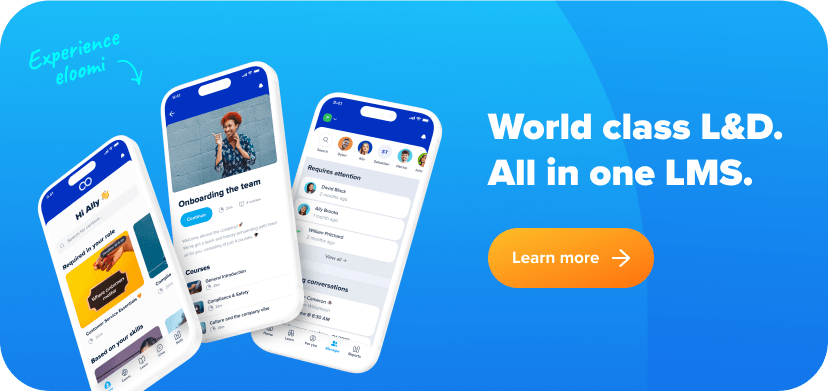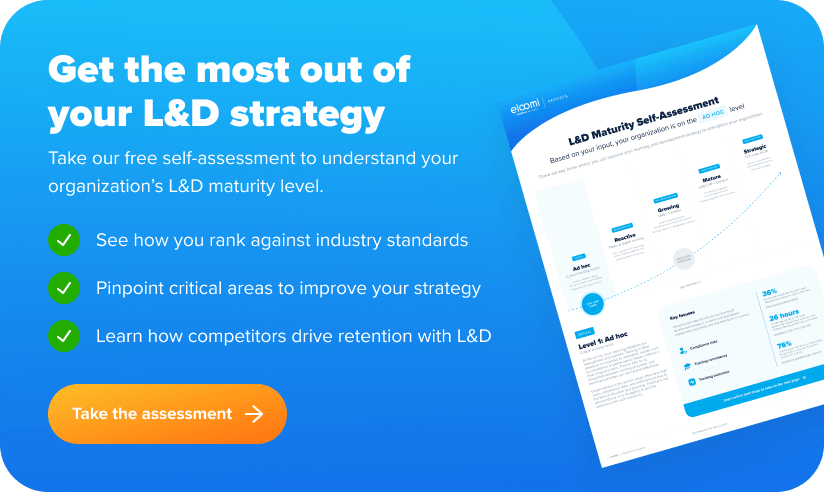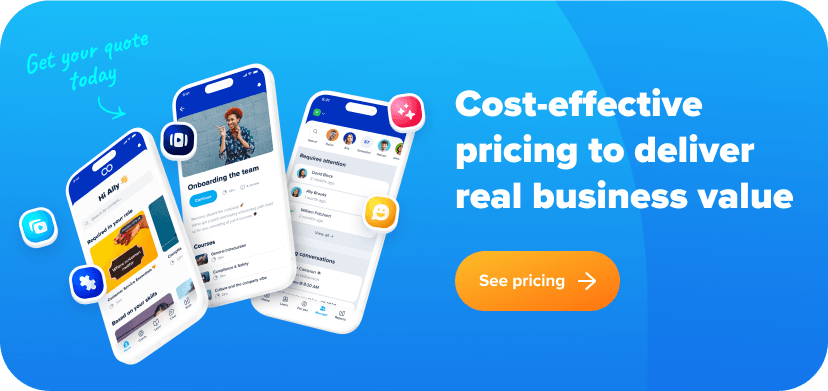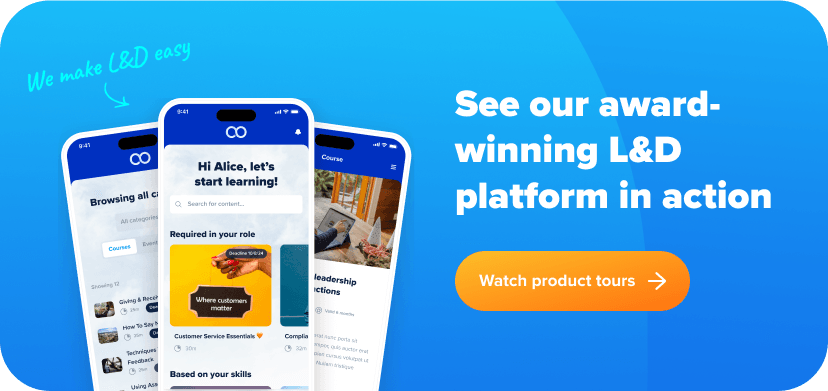According to recent research, 1 in 2 US employees now say they would switch to a new career if the employer offered upskilling opportunities. With the rise of hybrid work and labor market shortages, HR and L&D teams are facing increasing pressure to offer meaningful development to retain employees, and corporate training has become an essential part of their retention strategy.
In this article, we’ll answer what is corporate training and development, explore the different types of training, and show how elearning is beneficial in corporate training and development to help you retain, engage, and cultivate talent.
What is corporate training and development?
Corporate training is the process of equipping employees with the skills, knowledge, and tools they need to perform effectively in their roles and grow within their organization. It aims to drive both individual and organizational success by fostering professional development and aligning employee capabilities with business objectives.
This training can be delivered in various formats, including in-person workshops, online courses, job shadowing and coaching, mobile learning platforms, and streamlined corporate training solutions. Over recent years, corporate training has also evolved to meet changing workplace demands, incorporating AI-powered tools, microlearning, and other innovations to make learning more accessible and effective for diverse, often remote teams.
Why is corporate training so important in 2025?
Corporate training has become not only a tool for organizations to build consistent training processes that drive productivity and save time, but also a way to attract and retain talent. Since the global pandemic, hybrid and remote work have reshaped business operations, requiring employees to develop new skills and adapt to digital tools essential for distributed teams. Meanwhile, growing labor market shortages, skills gaps, and evolving employee expectations, have pushed talent to seek organizations that will truly invest in them.
Offering upskilling opportunities is now critical to maintaining an agile and capable workforce. In a recent survey, 70% of employees said they had left a role due to insufficient opportunities for career advancement, highlighting the need for meaningful training opportunities and support.
Corporate training addresses these challenges by aligning organizational goals with modern workforce needs. Businesses that invest in development opportunities through people development software are better positioned to attract top talent, enhance retention, and build resilience in a rapidly evolving landscape.

Benefits of elearning in corporate training and development
Digital training platforms have transformed corporate training since the days of paperwork, forms, and excel spreadheets. Corporate training platforms offer scalable, engaging, and cost-effective solutions to organizations worldwide. To find out why digital training is such a popular choice for growing businesses HR only need to look as far as the list of benefits organizations typically see when they switch to online training:
- Improved productivity: Employees can reach full productivity faster with structured onboarding and training material that they can access at any time
- Talent retention and attraction: Digital training supports further opportunities for development, demonstrating the organization’s commitment to growth and helping attract and retain top performers
- Higher employee engagement: Interactive and gamified learning experiences boost enthusiasm for training, raising completion rates and helping employees keep on top of material
- Faster onboarding: With automated digital training programs, new hires can get up to speed quickly with consistent and accessible onboarding material
- Time and resource savings: HR and L&D teams can manage training seamlessly across locations and as their organization grows, with tools to automate and manage all corporate training

Types of corporate training to consider
When creating your own corporate training program, there are multiple types of corporate training to consider. Organizations use training to ensure their employees are informed, up to date, and compliant with local regulations, as well as supporting further skills growth and development. Below, we explore key types of corporate training, along with examples, and highlight emerging approaches to corporate training that are reshaping learning and development.
Onboarding
Onboarding training is designed to help new hires integrate seamlessly into an organization. It introduces employees to company processes, their roles and responsibilities, and organizational culture, providing a strong foundation for success.
Effective onboarding accelerates productivity, reduces turnover, and fosters a sense of belonging. Examples include company orientation sessions, role-specific tutorials, and mentorship programs that guide employees through their initial weeks.
Compliance training
Compliance training ensures that employees adhere to essential legal and organizational standards, protecting the business and its workforce. From health and safety protocols to data privacy regulations, these programs minimize risks and promote a safe, ethical workplace.
Examples of compliance training include data privacy, anti-harassment, health and safety and cybersecurity awareness programs. By prioritizing compliance, companies can mitigate liability and foster a culture of accountability.
Leadership development
Leadership development programs prepare employees for management roles by honing skills in decision-making, communication, and team building. These initiatives are vital for cultivating a good ethos in your organization and ensuring consistency across leadership roles.
Examples include management bootcamps, executive coaching, and workshops focused on emotional intelligence or conflict resolution. Leadership training empowers employees to inspire and guide their teams effectively, driving long-term success.
Skills-based training
Skills-based training focuses on enhancing employees’ technical or soft skills to meet evolving organizational needs. This type of training can address a wide range of competencies, from coding and data analysis to negotiation and collaboration. By offering targeted skill development, organizations can improve team efficiency and retain talent by offering paths for career growth. Examples include programming courses, customer service workshops, and public speaking classes tailored to employee roles. However, these can also be highly industry-specific, depending on your organizational roles and needs.
As corporate training evolves, new formats are transforming how organizations deliver learning experiences. Hybrid learning, for example, blends in-person sessions with digital modules, provides flexibility for employees in both remote and on-site settings.
Many digital training platforms are now also exploring AI-assisted learning to help L&D professionals tailor content to individual learning styles and pacing to save time, enhance engagement and retention. Ultimately, adopting digital approaches to corporate training can help organizations support employee growth, adapt to change, compete in the market, and build consistent routines for otherwise time-consuming tasks.

Which corporate training solution should you choose?
To launch your corporate training program, learning management systems have become a popular choice for growing businesses. However, it’s important to choose the right corporate training solution and understand which platform features are relevant for your organization. Here are just a few features you should look out for:
- Accessibility: Is the learning platform designed to be easy to use and access? Will remote workers be able to log in and start training straight away? Is the platform available on mobile? And does the platform integrate with your current HRIS tools?
- Flexibility: Consider what kind of training content you need, as well as what resources you already have. A truly flexible corporate training platform will support both content authoring, allowing you to create custom training courses from scratch, content uploading, whether as PDFs, videos, or hosting SCORM files, as well as offering ready-made content so you can expand your training library as needed.
- Scalability: Be sure to check corporate training platform pricing to see how the platform scales with new users. This can be a good way to find a cost-effective training platform that’s right for your organization, while also considering how you expect your organization to grow in future so your training can always keep pace.
By leveraging digital learning platforms, businesses not only save time and resources on managing training, but HR teams are also empowered to create cohesive and effective training programs that can scale to meet the demands of a modern workforce. Choosing the right corporate training solution comes down to your organization’s needs, size, and ambitions. If you’d like to learn more, feel free to reach out to us to see how eloomi could support you with employee training.

How to align corporate training programs with overall business objectives
Corporate training programs can help you achieve key business goals such as training completion, employee engagement, or even retention. Platforms like eloomi can even connect employee training with performance management software, enabling you to create individual goals and objectives that are supported throughout your performance management process, whether in manager 1:1s or performance appraisals, eloomi can measure performance and help keep your teams on track for success.
To align your corporate training initiatives with your business objectives, consider the following key steps:
1. Set clear objectives
Define success for both the organization and employees. Objectives should be specific, measurable, and directly tied to the business’s priorities, such as revenue growth, employee retention, or engagement.
2. Integrate training with strategic goals
Explore training programs that address pressing business challenges or capitalize on emerging opportunities. For example, if productivity is a priority, consider creating onboarding programs that can help employees get to full productivity faster.
3. Measure outcomes
Use key performance indicators (KPIs) to assess the impact of training on areas like productivity, customer satisfaction, or employee retention. In a typical corporate training platform, you’ll be able to access reporting and analytics on employee training completion as well as other metrics.
4. Encourage leadership buy-in
Secure executive support to foster a culture of continuous learning. When leadership actively promotes and participates in training, it emphasizes its importance and motivates employees to engage fully.
By aligning your training programs with overarching business objectives, you can create a structured pathway for growth and success, empowering both employees and the organization to achieve their full potential.

Best practices for delivering corporate training
Corporate training doesn’t have to be boring. By incorporating these best practices, organizations can deliver corporate training programs that are engaging, effective, and aligned with their strategic goals, ultimately driving long-term success. Here’s our summary of the best practices you should adopt to make your corporate training effective:
1. Define training needs and goals
Effective corporate training begins with setting clear, measurable objectives that align with the organization’s broader goals. These objectives provide a roadmap for the training program, ensuring that it addresses specific challenges or opportunities within the company.
By linking training to strategic priorities, you can ensure that the investment delivers tangible value, such as improved productivity, enhanced skills, or increased employee engagement.
2. Develop relevant, customized content
Relevance is key to the success of any training program. Tailored content that reflects the unique needs of employees not only makes the material more engaging but also ensures that it is directly applicable to their roles.
Customized training programs demonstrate a commitment to employee growth, fostering a deeper connection between the workforce and the organization. When content resonates with learners, it leads to better retention and application of knowledge in the workplace.
3. Engage employees with interactive learning
Keeping employees actively involved in their learning journey is essential for driving engagement and ensuring program effectiveness. Interactive delivery methods—such as gamification, quizzes, or feedback discussion—make training dynamic and enjoyable. Including formats like video and iFrames can help capture attention and engage learning, which is critical for retaining new skills and knowledge.
4. Support continuous learning with follow-up
Training shouldn’t end once a session concludes. To maximize its impact, organizations should provide follow-up resources or encourage trainer check-ins to create opportunities for continuous learning.
Follow-up discussions or refresher courses help employees reinforce what they’ve learned and apply it more effectively in their roles. Encouraging feedback also creates a culture of improvement, enabling the training program to evolve and remain relevant over time.
Get started with corporate training
Corporate training is essential for organizations aiming to retain top talent, close skills gaps, and remain competitive in a rapidly evolving workplace.
Whether focusing on onboarding, compliance, or leadership development, investing in modern solutions like eloomi can help you make training more engaging, efficient, and aligned with your business goals.
Discover how eloomi can help you design and implement successful corporate training programs.






